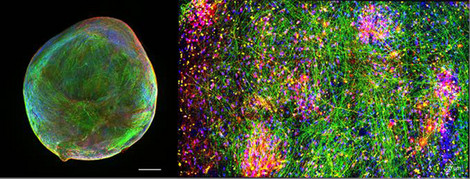Development of the GABA polarity switch and neuronal plasticity in biotechnologically produced neuronal organoids
For the first time, scientists from UMG and the Cluster of Excellence "Multiscale Bioimaging" (MBExC) and the German Center for Neurodegenerative Diseases (DZNE) have succeeded in creating neuronal networks with functions of the human brain from human, induced pluripotent stem cells. The tissues known as Bioengineered Neuronal Organoids (BENOs) show the morphological properties of the human brain. They also develop functions that are important for the development of learning and memory functions. Published in Nature Communications.

Source: Göttingen University Medical Center: images from Zafeiriou et al. (2020) GABA polarity switch and neuronal plasticity in Bioengineered Neuronal Organoids. Nat Commun, 11, 3791.
Left: Representation of a “Bioengineered Neuronal Organoid” (BENO) produced according to one of Zafeiriou et al. published procedure; the formation of the neural network structure is shown by the coloring of neural marker proteins (microtubule-associated protein 2; blue) and neurofilament (green) as well as glial cells (glial fibrillary acidic protein; red). Scale: 0,5 mm. Right: Enlargement of the neural network structure in a BENO. After the neurofilament protein is colored, neuronal axons are shown in green, activating glutamatergic neurons in red and cell nuclei in blue
Brain organoids are promising tools for disease modeling and drug development. For the correct formation of a neural network, both excitatory and inhibitory neurons and glial cells must develop together. Here we report on the directed self-organization of human-induced pluripotent brain stem organoids. Brain organoids are promising tools for disease modeling and drug development. For the correct formation of a neural network, both excitatory and inhibitory neurons as well as glial cells must develop. Here we report on the directed self-organization of human-induced pluripotent stem cells in a collagen hydrogel in the direction of a highly networked neural network in the macroscopic tissue format. Biotechnologically engineered neural organoids (BENOs) comprise interconnected excitatory and inhibitory neurons with supportive astrocytes and oligodendrocytes. Gigantic events with depolarizing potential (GDP), as observed in early BENO cultures, mimick the early network activity of the fetal brain. The observed GABA polarity change and reduced GDPs in> 40 days BENO indicate a progressive maturation of the neural network. BENOs show accelerated development of complex network bursts after two months and signs of long-term potentiation. The similarity of structural and functional properties to those of the fetal brain could allow BENOs to be used in studies of neural plasticity and disease modeling. Cells in a collagen hydrogel into a highly interconnected neural network in a macroscale tissue format. Biotechnologically engineered neural organoids (BENOs) comprise interconnected excitatory and inhibitory neurons with supportive astrocytes and oligodendrocytes. Gigantic events with depolarizing potential (GDP), as observed in early BENO cultures, mimick the early network activity of the fetal brain. The observed GABA polarity change and reduced GDPs in> 40 days BENO indicate a progressive maturation of the neural network. BENOs show accelerated development of complex network bursts after two months and signs of long-term potentiation. The similarity of structural and functional properties to the fetal brain could enable BENOs to be used in studies of neural plasticity and disease modeling.